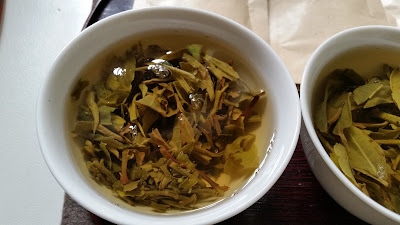Im Juni fand das dritte Teezui statt, das Offline-Treffen des Forum TeeTalk: ein Wochenende im Kreis vollkommen vernünftiger Menschen! Menschen die völlig rational begründen können, warum man seinen letzten Cent für Tee und -zubehör ausgibt.
Dieses Jahr fand das Treffen im Chá Dào in Neu-Isenburg statt: Diese heiligen Hallen waren das pefekte Setting! Seit dem ersten Besuch dort recke ich auch am heimischen Teetisch gerne meine Teetasse vor dem ersten Schluck in Richtung Neu-Isenburg und schicke in Gedanken einen begeisterten Gruß an den Inhaber Gerhard Thamm!
Einer der Tees, die ich mir bei der Teezui gekauft habe, ist der Yi Bi Hong Sheng Sen Cha.
Der Duft der feuchten Blätter ist eindeutig mehr ... Mann oh Mann oh Mann, ist es nicht völlig egal, ob wir den Tee jetzt Schwarz, Sheng oder Maocha nennen?
Dann der Tee in der Tasse: dunkel, warm, weich und kraftvoll - einfach lebendig, spritzig und mitreißend. Ja, der Geschmack ist der von Schwarztee, irgendwie. Wo sind die Fruchtnoten und der Malzgeschmack guter chinesischer Hongcha (=Schwarztee) ... die sind da bestimmt auch irgendwo, aber eigentlich sind die gerade total nebensächlich! Der Tee wirbelt und tanzt durch meinen Mund, geht gleich in mein Herz - rauscht am Großhirn vorbei direkt ins Rückenmark und ich träume, schwebe, fühle mich wie ein Lied.
Was sollen die viele Worte?! Einfach mal dieses Lied hören ( Kopfhörer, laut und die erste Minute mindestens abwarten bis zum Urteil):
Im Chá Dào gibt es viele Hongcha, die betörende Süße, Fruchtigkeit dunkler Trauben, Noten von Süßholz und Gewürzen aufweisen - eine grandiose Auswahl. Obwohl ich gerne jeden der probierten Hongcha zur Verfügung hätte, hat mich keiner so dermaßen umgehauen wie dieser, der sich gar nicht so genau beschreiben lässt.
Wenn ich von meinen 17 Wolken im Teehimmel heruntergetanzt bin und die Blätter nach dem 12 Aufguss ruhiger geworden sind, blicke ich auf die feuchten Blätter und beginne schon wieder vor Schwärmerei zu seufzen.
Ganz herzlichen Dank an Gerhard Thamm, dass er sein Chá Dào für uns Teeverrückte geöffent hat!


































